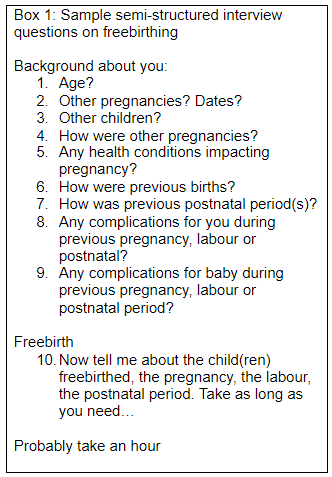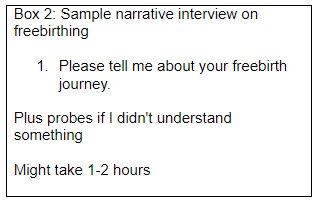The narrative method
Gemma: Storytelling is a powerful way of communicating a message. This is the foundation of narrative interviews. The method provides an interviewee with the freedom to tell their story in a way that is meaningful to them. The data is therefore rich and filled with plots, sub-plots, characters and the personality of the person being interviewed. It also helps shift the balance of power away from the interviewer and their perspectives and places the interviewee at the centre of their own story. For an introduction to some of the different approaches in narrative, the book “Narrative Research in Health and Illness” edited by Brian Hurwitz, Trisha Greenhalgh and Vieda Skultans is an interesting and useful read.
Sophie: But what I want to know is what you actually do when you’re talking to someone in a narrative-style interview! So if I were to design a study on freebirthing, my default would be a semi-structured interview, partly because this is my go-to, but partly because I have so many questions about freebirthing.
Not the why, I think Claire Feeley has covered this as has your recent literature review (it’s not self-promotion if someone else does it for you!), but about the interviewee’s medical history: first, second, third, fourth child? Were previous pregnancies uneventful?
A semi-structured interview
Sophie: Here is the semi-structured interview guide I’d put together to interview someone about their freebirth experience:

A narrative interview
Sophie: So what did you do for your interviews?
Gemma: Before I began interviewing I did a lot of preparation. I had volunteered for a national human rights charity called AIMS (Association for Improvements in the Maternity Services), which supports women as they navigate the NHS maternity system. I had also met with women who had freebirthed and discussed their experiences in some detail. None of this information formed part of the data, but it did inform me of the type of issues women may report.
This form of public and patient involvement (PPI) meant that there would never have been a need to create a very structured interview. I knew women’s stories would be complex and that very specific questions may limit their ability to share their experiences with me. Although I had done a lot of preparation, I also didn’t want to pre-empt what women would say and make presumptions about a very delicate subject and personal area of a woman’s life.
Prior to the interview, I arranged a phone call with each woman. This was to confirm the details of our meeting, but it was also an opportunity for me to provide more information on the project. What happened in each call – and in a very organic way – was that we spoke about our birth experiences and shared our own insights into the NHS maternity system. It gave women a chance to get to know me and for me to share some personal aspects of my life.
I was very honest in this respect as I feel this is only fair, if I am to expect a woman to open up to me in an interview about her private life. All of these calls were unrecorded and lasted up to an hour. The conversation usually flowed into topics such as maternity policy, trauma, the medicalisation of birth, coercion, informed consent - wherever the conversation went. I really didn’t want the interviewees to feel as if I had come into their homes, grabbed as much information as I could and then disappeared...
Sophie: …guilty as charged…
Gemma: … I wanted to form a different type of relationship so I’d let the interviewees get to know me first. After that first conversation, then I’d confirm the formal interview at a time and location convenient to them. It was mostly in their homes, lasting an hour or two with an extra hour or two for chit chat, tea, lunch etc.
So the interview guide for my narrative interviews looked like this:

Blundering in?
Sophie: Yeah, that’s quite different to my interview schedule above. Can you speculate about some advantages and disadvantages? I wonder if all my warm-up questions might be too intrusive, especially if I haven’t spent an hour getting to know the interviewee?
Gemma: Hmmmm, I hate to say it, but I think your interview schedule is a bit presumptuous...
Sophie: ...It's okay, say it. That's why we're having this discussion!
Gemma: ...It presumes that a woman’s freebirth decision is linked to previous births. The reality is though, that this isn’t always the case. In my cohort, four women freebirthed their first babies – so if you had conducted those interviews, you may have struggled to ask something meaningful if you had relied solely on your interview schedule!
Using a narrative approach also ensures that the interviewee retains the power to direct the course of the conversation, and this is important in a subject like freebirth. In my study, one interviewee hinted that she’d had a previous traumatic birth (one reason that some people decide to freebirth) but didn’t dwell on it, indicating she definitely did not want to discuss it. I think using a narrative interview made sure that her decision was respected.
Sophie: Ah, yes, my warm-up questions would definitely not be appropriate. She’d either not answer them, or get flustered and upset, and that would spoil the telling of the freebirth story. It would be difficult and uncomfortable for everyone.
Gemma: I didn’t collect the demographic/quantitative information in your warm-up questions as I didn’t think it was actually relevant to the telling of someone’s freebirthing journey. In fact, I told women that I would not be collecting information on demographics, but that if they thought this information was relevant to their story, they should bring it in. Women very rarely did.
Other topics or approaches?
Sophie: I’m aware of a narrative approach being used to tell food histories, or people’s perception of the history of certain foodstuffs and its role in their lives (eg Peter Jackson’s work on food histories in the chicken and sugar industries).
Gemma: For a good overview of narrative interviews, this article on personal experiences taking antidepressants may be helpful: Claire Anderson and Susan Kirkpatrick, “Narrative Interviewing”
I think it is important to also highlight that using a narrative interview is only one way to respect the importance of storytelling in people’s lived experiences when carrying out social science research. The idea of narrative can be used in many different ways, not just in interviews. You can do, for example, a meta-narrative, a narrative analysis or an analysis of narrative!
Sophie: Are you volunteering to write more on narrative approaches?
Gemma: Ha, we’ll see. There are so many different approaches but using narrative in interviews is a relatively straightforward approach to data collection. It works because it reflects the way two people would ordinarily communicate stories to each other and share experiences.
Training
Gemma: I didn’t undergo specific training in narrative interviewing techniques, but I did read a lot about my subject area, engaged with freebirthing women beforehand and read many studies that had employed narrative interviews. The main thing though, is that you need to be confident enough to dive into an interview without a script or cribsheet. You need to be flexible so that an interviewee can take you along on their journey and for the conversation to flow in directions you may not have anticipated. There is no real preparation you can do for that – except to simply have a go!
Author Bios:
Gemma McKenzie is a PhD researcher at Florence Nightingale Faculty of Nursing, Midwifery and Palliative Care at Kings College London. Her academic background is in law, human rights, bioethics and public health.
Sophie Payne-Gifford is a food systems researcher at the University of Hertfordshire and qualitative editor for the SRA blog. Sophie also has an interest in maternal and infant health research and volunteered with the Parenting Science Gang collective which she has blogged about here.
Acknowledgements:
Gemma’s PhD is funded by the Economic and Social Research Council
The SRA runs a training course on
Narratives and storytelling in qualitative research